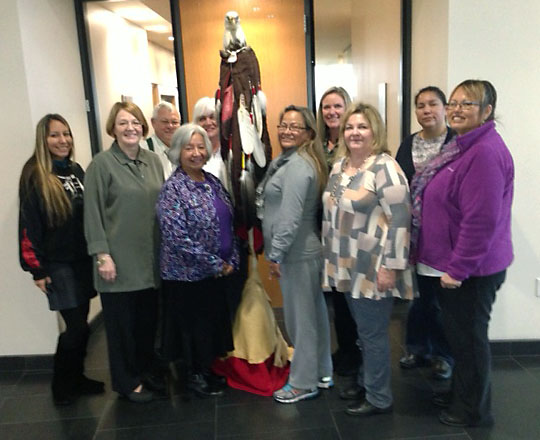Breadcrumb
American Indian and Alaska Native Leadership Academy: Passing the feather from generation to generation
Published on October 28, 2014

Not pictured: Brent Lierman, Sean Bear, Mandy Conrad, Arlene Kashata, William Martin, Richard Moreno, Dale Walker, Kellie Webb, Lakota Holman, and Myron Lee Little Bird.
Many leaders of behavioral health programs in tribal communities have expressed concerns about the aging workforce, especially among leaders of substance abuse and mental health prevention and treatment programs.
To help develop future leaders in these professions, the National American Indian and Alaska Native Addiction Technology Transfer Center (ATTC) based in the UI College of Public Health recently launched a pilot training program called the American Indian & Alaska Native Leadership Academy for behavioral health professionals.
The Leadership Academy lasts about nine months and consists of three face-to-face events, webinars, regular conference calls, and mentor support. Over the course of their training, participants develop their personal leadership qualities, learn from their mentor, and develop a project to be implemented towards the end of the program. The mentees are also expected to present their projects and to enhance their public speaking skills.
Developing leaders
The first Immersion Training session took place Aug. 11-15, 2014, in Tama, Iowa, and included five mentees and three mentors representing a number of different tribes from around the country.
The curriculum is based on content previously developed by the Southern Coast ATTC, often referred to as the ATTC Leadership Institute.
“As a regional center formerly called the Prairielands ATTC, we offered this program annually for close to 10 years,” notes Anne Helene Skinstad, the center’s program director and clinical associate professor of community and behavioral health. “However, after Prairielands ATTC became a National Focus Area ATTC, we embarked on a cultural adaptation together with American Indian and Alaska Native task force members.”
The adaption was made with the input of tribal leaders who convened at the University of Iowa in October 2013 for a two-day Leadership Academy Task Force Meeting (see photo above). The task force meeting was facilitated by the original author of the training program, Pam Waters. One significant overall change was to emphasize the role of mentoring in leadership development.
“The mentoring concept is much more in tune with the tribal culture than a top-down protégée model of leadership,” says Skinstad, who adds that the curriculum was re-tooled to fit broadly shared cultural aspects of American Indian and Alaska Native leadership styles and decision-making processes. “Face-to-face interaction is important as well,” Skinstad notes.
A diversity of cultures
Above all is a respect for the participants’ different cultures, and the program continues to be modified as necessary.
“It’s a consensus program that’s under continuous revision since we have people from many different tribal backgrounds,” Skinstad explains. “Also, the diversity of cultures across the country led us to require the mentees to do homework before they came to the training. Their assignment was to connect with tribal elders who had influence over the behavioral health initiatives in their community and to share their experiences with the other mentees and mentors.”
The center also makes an effort to integrate different symbols, rituals, and aspects from the various tribal cultures.
“We ask participants to share their cultural background,” says Skinstad. “And when we have an event such as a meeting, we hold it on tribal property. This gives a clear concept of the diversity in American Indian and Alaska Native cultures.”
At the end of the nine-month training, all the mentors and mentees will gather to acknowledge their accomplishments. Mentees will present their individual projects and participate in a special ceremony with current leaders in the field. Mentees also will be awarded a formalized certificate of proficiency.
“The goal is for the mentees to go on to leadership positions in behavioral health and in the tribal government,” says Skinstad. “Additionally, it’s important for the mentees to have an understanding of both worlds—tribal and non-tribal–to be successful as leaders. Our experiences from previous Leadership Institutes is that our participants really entered in leadership roles across the region. Time will tell if the cultural adaptation of the Leadership Academy yields similar results. The center is in the process of starting the evaluation process.”